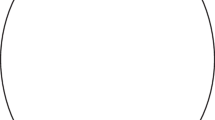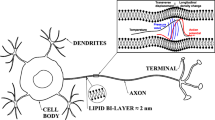Abstract
Calculation of the response of human myelinated sensory nerve fibres to spinal cord stimulation initiated the development of a fibre model based on electro-physiological and morphometric data for human sensory nerve fibres. The model encompasses a mathematical description of the kinetics of the nodal membrane, and a non-linear fibre geometry. Fine tuning of only a few, not well-established parameters was performed by fitting the shape of a propagating action potential and its diameter-dependent propagation velocity. The quantitative behaviour of this model corresponds better to experimentally determined human fibre properties than other mammalian, non-human models do. Typical characteristics, such as the shape of the action potential, the propagation velocity and the strength-duration behaviour show a good fit with experimental data. The introduced diameter-dependent parameters did not result in a noticeable diameter dependency of action potential duration and refractory period. The presented model provides an improved tool to analyse the electrical behaviour of human myelinated sensory nerve fibres.
Similar content being viewed by others
References
Behse, F. (1990): ‘Morphometric studies on the human sural nerve’,Acta Neurol. Scand.,82, Suppl. 132, pp. 1–38
Bement, S. L., andRanck, J. B. (1969): ‘A quantitative study of electrical stimulation of central myelinated fibers with monopolar electrodes’,Exp. Neurol.,24, pp. 147–170
Bostock, H. (1983): ‘The strength-duration relationships for excitation of myelinated nerve: computed dependence on membrane parameters’,J. Physiol.,341, pp. 59–74
Bostock, H., andRothwell, J. C. (1997): ‘Latent addition in motor and sensory fibres of human peripheral nerve’,J. Physiol. (London),498, pp. 227–294
Boyd, I. A., andKalu, K. U. (1979): ‘Scaling factor relating conduction velocity and diameter for myelinated afferent nerve fibres in the cat hind limb’,J. Physiol.,289, pp. 277–297
Buchthal, F., andRosenfalck, A. (1966): ‘Evoked action potentials and conduction velocity in human sensory nerves’,Brain Res.,3 (special issue)
Burton, C. (1975): ‘Dorsal column stimulation: optimization of application’,Surg. Neurol.,4, pp. 171–176
Chiu, S. Y., Ritchie, J. M., Rogart, R. B., andStagg, D. (1979): ‘A quantitative description of membrane currents in rabbit myelinated nerve’,J. Physiol.,292, pp. 149–166
Frankenhaeuser, B., andHuxley, A. F. (1964): ‘The action potential in the myelinated nerve fibre of Xenopus Leavis as computed on the basis of voltage clamp data’,J. Physiol.,171, pp. 302–315
Frijns, J. H., Mooij, J., andTen Kate, J. H. (1994): ‘A quantitative approach to modeling mammalian myelinated nerve fibers for electrical prosthesis design’,IEEE Trans. Biomed. Eng.,41, pp. 556–566
Frijns, J. H. M., andTen Kate, J. H. (1994): ‘A model of myelinated nerve fibres for electrical prosthesis design’,Med. Biol. Eng. Comput.,32(4), pp. 391–398
Gilliat, R. W., andWilson, R. G. (1963): ‘The refractory and supernormal periods of the human median nerve’,J. Neurol. Neurosurg. Psychiat.,26, pp. 136–147
Hodgkin, A. L., andHuxley, A. F. (1952): ‘A quantitative description of membrane currents and its application to conduction and excitation in nerve’,J. Physiol.,117, pp. 500–544
Ishikawa, M., Ohira, T., Yamaguchi, N., Takase, M., Berta-Lanffy, H., Kawase, T., andToya, S. (1996): ‘Strength-duration of conductive spinal cord evoked potentials in cats’,Electroenceph. Clin. Neurophysiol.,100, pp. 261–268
Jankowska, E., andRoberts, W. J. (1972): ‘An electrophysiological demonstration of the axonal projections of single spinal interneurons in the cat’,J. Physiol.,222, pp. 597–622.
McNeal, D. R. (1976): ‘Analysis of a model for excitation of myelinated nerve’,IEEE Trans. Biomed. Eng.,23, pp. 329–337
Mogyros, I., Kiernan, M. C., andBurke, D. (1996): ‘Strengthduration properties of human peripheral nerve’,Brain,119, pp. 439–447
Nowak, L. G., andBullier, J. (1998): ‘Axons, but not cell bodies, are activated by electrical stimulation in cortical gray matter: I. Evidence from chronaxie measurements’,Exp. Brain Res.,118, pp. 477–488
Paintal, A. S. (1966): ‘The influence of diameter of medullated nerve fibers of cat on the rising and falling phases of the spike and its recovery’,J. Physiol.,184, pp. 791–811
Paintal, A. S. (1973): ‘Conduction in mammalian nerve fibres’,in Desmedt, J. E. (Ed.): ‘New developments in electromyography and clinical neurophysiology’ (Karger, Basel), pp. 19–41
Paintal, A. S. (1978): ‘Conduction properties of normal peripheral mammalian axons’,in Waxman, S. G. (Ed.): ‘Physiology and pathobiology of axons’ (Raven Press, New York) pp. 131–144
Panizza, M., Nilsson, J., Roth, B. J., Rothwell, J. andHallett, M. (1994): ‘The time constants of motor and sensory peripheral nerve fibers measured with the method of latent addition’,Electroenceph. Clin. Neurophysiol.,93, pp. 147–154
Panizza, M., Nilsson, J., Roth, B. J., Grill, S. E., Demirci, M., andHallet, M. (1998): ‘Differences between the time constant of sensory and motor peripheral nerve fibers: further studies and considerations’,Muscle & Nerve,21, pp. 48–54
Rattay, F., andAberham, M. (1993): ‘Modeling axon membranes for functional electrical stimulation’,IEEE Trans. Biomed. Eng.,40, pp. 1201–1209
Rubinstein, J. T. (1991): ‘Analytical theory for extracellular electrical stimulation of nerve with focal electrodes: II. Passive myelinated axon’,Biophys. J.,60, pp. 538–555
Schalow, G., Zäch, G. A., andWarzok, R. (1995): ‘Classification of human peripheral nerve fiber groups by conduction velocity and nerve fiber diameter is preserved following spinal cord lesion’,J. Aut. Nervous Syst.,52, pp. 125–150
Scholz, A., Reid, G., Vogel, W., andBostock, H. (1993): ‘Ion channels in human axons’,J. Neurophysiol.,70, pp. 1274–1279
Schwarz, J. R., andEikhof, G. (1987): ‘Na-currents and action potentials in rat myelinated nerve fibers at 20 and 37°C’,Pflugers Arch.,409, pp. 569–577
Schwarz, J. R., Reid, G., andBostock, H. (1995): ‘Action potentials and membrane currents in the human node of Ranvier’,Eur. J. Physiol.,430, pp. 283–292
Struijk, J. J., Holsheimer, J., Van Der Heide, G. G., andBoom, H. B. K. (1992): ‘Recruitment of dorsal column fibers in spinal cord stimulation: Influence of collateral branching’,IEEE Trans. Biomed. Eng.,39, pp. 903–912
Struijk, J. J., Holsheimer, J., Barolat, G., He, J., andBoom, H. B. K. (1993): ‘Paresthesia thresholds in spinal cord stimulation: A comparison of theoretical results with clinical data’,IEEE Trans. Rehab. Eng.,1, pp. 101–108
Sweeney, J. D., Mortimer, J. T., andDurand, D. (1987): ‘Modeling of mammalian myelinated nerve for functional neuromuscular stimulation’,Proc. IEEE 9th Conf. of the EMBS, pp. 1577–1578
Tackmann, W., andLehmann, H. J. (1974): ‘Refractory period in human sensory nerve fibers’,Eur. Neurol.,12, pp. 277–292
Van Veen, B. K., Schellens, R. L. L. A., Stegeman, D. F., Schoonhoven, R., andGabreëls-Festen, A. A. W. M. (1995): ‘Conduction velocity distributions in normal human sural nerve’,Muscle & Nerve,18, pp. 1121–1127
Veltink, P. H., Van Veen, B. K., Struijk, J. J., Holsheimer, J., andBoom, H. B. K. (1989): ‘A modeling study of nerve fascicle stimulation’,IEEE Trans. Biomed. Eng.,36, pp. 683–692
Weiss, G. (1901): ‘Sur la possibilité de rendre comparables entre eux les appareils servant à l'excitation électrique’,Arch. Ital. de Biol.,35, pp. 413–446
Wesselink, W. A., Holsheimer, J., Nuttin, B., Boom, H. B. K., King, G. W., Gybels, J. M., andDe Sutter, P. (1998): ‘Estimation of fiber diameters in the spinal dorsal columns from clinical data’,IEEE Trans. Biomed. Eng. (in press)
West, D. C., andWolstencroft, J. H. (1983): ‘Strength-duration characteristics of myelinated and non-myelinated bulbospinal axons in the cat spinal cord’,J. Physiol.,337, pp. 37–50
Author information
Authors and Affiliations
Corresponding author
Additional information
An erratum to this article is available at http://dx.doi.org/10.1007/BF02513344.
Rights and permissions
About this article
Cite this article
Wesselink, W.A., Holsheimer, J. & Boom, H.B.K. A model of the electrical behaviour of myelinated sensory nerve fibres based on human data. Med. Biol. Eng. Comput. 37, 228–235 (1999). https://doi.org/10.1007/BF02513291
Received:
Accepted:
Issue Date:
DOI: https://doi.org/10.1007/BF02513291




